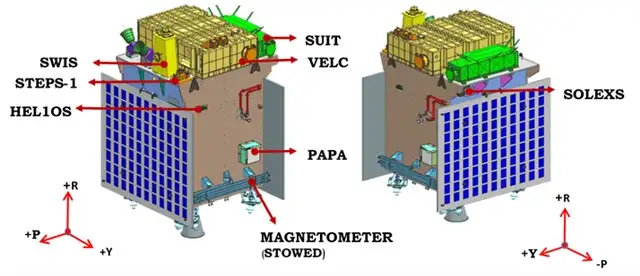Chandrayaan 3’s historic success has not even been completed for two weeks. But ISRO is once again going to create history. Aditya L1 mission. Today, ISRO’s eyes are not on the Moon, but on the Sun. Let’s understand Aditya L1 mission in depth in today’s article.
The Aditya L1 Mission: A Solar Odyssey
Aditya L1 is India’s pioneering mission dedicated to the study of the Sun. Similar to Chandrayaan’s lunar exploration, Aditya won’t land on the Sun but will meticulously observe it from a distance. In fact, this spacecraft will remain closer to Earth during the mission with the Sun.
After the launch, it will journey approximately 15 lakh kilometers away from Earth to orbit around Lagrange point L1 in a halo orbit. The journey to this point will take about four months from the launch. Once it reaches L1, it will remain there for five years, observing the Sun.
Here is the brochure: https://t.co/5tC1c7MR0u
— ISRO (@isro) September 1, 2023
and a few quick facts:
🔸Aditya-L1 will stay approximately 1.5 million km away from Earth, directed towards the Sun, which is about 1% of the Earth-Sun distance.
🔸The Sun is a giant sphere of gas and Aditya-L1 would study the… pic.twitter.com/N9qhBzZMMW
Aditya-L1 Mission:
— ISRO (@isro) September 4, 2023
The second Earth-bound maneuvre (EBN#2) is performed successfully from ISTRAC, Bengaluru.
ISTRAC/ISRO's ground stations at Mauritius, Bengaluru and Port Blair tracked the satellite during this operation.
The new orbit attained is 282 km x 40225 km.
The next… pic.twitter.com/GFdqlbNmWg
Understanding Lagrange Points
Lagrange points are unique spots in space where the gravitational forces of two celestial bodies balance out. When we consider the Sun and the Earth, five Lagrange points are formed.
These points allow spacecraft to stay in a stable position, as the gravitational forces of the Earth and the Sun cancel each other out. This stability not only conserves spacecraft fuel but also ensures continuous observation, making it ideal for Aditya L1 mission.
Significance of Lagrange 1 (L1)
Lagrange 1 (L1) is particularly significant because it provides an unobstructed view of both the Earth and the Sun. Unlike other points where the Earth and Sun can hide behind each other during a mission, L1 allows uninterrupted observation.
Aditya L1’s name is derived from its position at L1, and it follows the tradition of other solar observatories placed at this crucial point.
The Sun: A Celestial Giant
To appreciate what Aditya L1 will study, we must understand the Sun. The Sun is a colossal celestial body in our solar system, with a diameter approximately 109 times greater than that of Earth and a weight around 333,000 times greater.
To put it in perspective, you could fit 1.3 million Earths inside the Sun. Just as Earth has different layers like the core, mantle, and crust, the Sun also has distinct layers.
The Sun's Layers
- The Core: This is the Sun’s innermost layer, where nuclear fusion reactions occur, converting hydrogen and helium into energy. The core’s temperature can reach up to a scorching 15 million degrees Celsius.
- Radiative Zone: Constituting about 70% of the Sun’s radius, this layer is responsible for energy transfer through radiation.
- Convective Zone: Making up roughly 30% of the Sun’s radius, this zone facilitates energy transfer through convection.
- Photosphere: The Sun’s visible surface, composed of hot gases and plasma, with a temperature of around 5,500 degrees Celsius. This is where sunlight and heat originate.
- Chromosphere: Located above the photosphere, the temperature in this layer ranges from 6,000 to 20,000 degrees Celsius. million degrees Celsius.
- Transition Region: A thin layer that separates the chromosphere from the outermost layer, the corona.
- Corona: The outermost layer, characterized by extremely hot plasma, with temperatures ranging from 1 to 3 million degrees Celsius.
The Mystery of Temperature Variations
One of the intriguing mysteries surrounding the Sun is why its core is scorching hot while the surface cools down, only for the corona layer to become intensely hot again. Scientists have proposed various theories, but the exact reason remains elusive. Aditya L1 mission might shed some light on this enigma.
Aditya L1: Unveiling Solar Secrets
Aditya L1 mission will focus on studying three layers of the Sun: the photosphere, chromosphere, and corona. To achieve this, it’s equipped with seven specialized instruments:
Visible Emission Line Coronagraph (VELC):
This VELC instrument will observe the coronal layer and monitor coronal mass ejections.
Solar Ultraviolet Imaging Telescope (SUIT):
SUIT will capture ultraviolet images of the sun’s photosphere and chromosphere.
Solar Low Energy X-ray Spectrometer (SOLEX):
High Energy L1 Orbiting X-ray Spectrometer (HELIOS):
Aditya Solar Wind Particle Experiment (ASPEX):
Plasma Analyzer Package For Aditya (PAPA):
Magnetometer MAG:
MAG will measure magnetic fields at the L1 point.
These instruments will provide invaluable data, helping scientists better understand the Sun’s behaviour and its impact on our solar system.
Unveiling Solar Mysteries
While Aditya L1 mission embarks to unlock the Sun’s secrets, the mysteries of temperature variations and solar phenomena remain captivating puzzles for scientists to solve. As we look forward to the findings from this mission, we continue to marvel at the wonders of our solar system.
Conclusion
Aditya L1 mission represents another remarkable milestone in ISRO’s quest for scientific exploration. As it journeys closer to the Sun, humanity moves a step closer to unraveling the celestial secrets that have puzzled us for centuries.
Frequantly Asked Questions (FAQs)
1. What is the primary goal of the Aditya L1 mission?
The primary goal of the Aditya L1 mission is to study the Sun, particularly its photosphere, chromosphere, and corona, to better understand solar phenomena and behavior.
2. Why is Lagrange 1 (L1) a crucial point for solar observatories like Aditya L1?
Lagrange 1 (L1) provides an unobstructed view of both the Earth and the Sun, allowing continuous and stable observation, making it an ideal position for solar observatories.
3. How will Aditya L1 measure temperature variations on the Sun?
Aditya L1 is equipped with specialized instruments, including spectrometers and imaging devices, to measure temperature variations and study the Sun’s different layers.
4. What are some of the dangers associated with solar phenomena like solar flares and coronal mass ejections?
Solar flares and coronal mass ejections can disrupt satellite communication, damage electrical grids, and pose radiation hazards to astronauts and spacecraft.
5. What is the significance of studying the Sun's magnetic fields?
Studying the Sun’s magnetic fields is crucial for understanding solar activity, including the formation of sunspots, solar flares, and coronal mass ejections.


